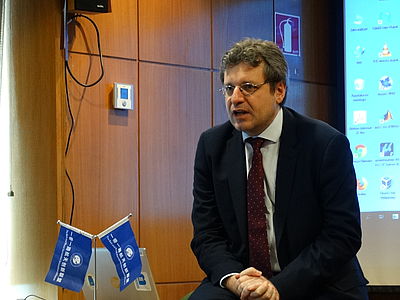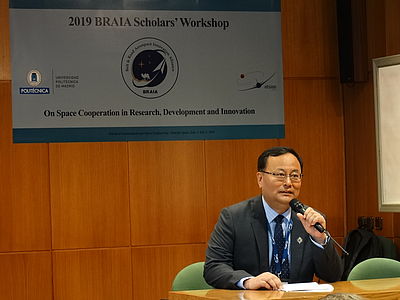After only 9 months since the Technical School of Aeronautical and Space Engineering (ETSIAE, Escuela Técnica Superior de Ingeniería Aeronáutica y del Espacio) joined the international network BRAIA, the alliance has begun to show some results with a meeting of the researchers of the network: “BRAIA Scholars' Workshop 2019", which is also the first activity organised by this international alliance in Europe and one of the first held outside China.

BRAIA currently has 51 members, aerospace universities, research institutions and academic organisations across Asia, America, Europe and Africa. Thus, the 48 attendees of "BRAIA Scholars' Workshop 2019" at ETSIAE come mostly from China, but also from Russia, Cameroon, Egypt, Argentina, Italy or Belgium and, of course, from the host institution, the Universidad Politécnica de Madrid (UPM).
The UPM's Vice-Rector for Academic Strategy and Internationalisation, José Miguel Atienza, opens this event, which is an opportunity to establish synergies with other professors and researchers involved. “From UPM we will provide as much support as possible to this network," he says. His counterpart from the Northwestern Polytechnical University of China, Song Baowei, who also took part in the opening, advocates the "cooperation" as the key value of this alliance and supports that "these events organised by BRAIA increase that cooperation among members concerning development, research and aerospace innovation.”

During the three-day meeting, several conferences are carried out to deal with specific aspects related to nanosatellites, propulsion, combustion, composite materials and even drones. The speakers explain projects in which they are working within their respective institutions, universities and companies where they come from, and in the specific case of the ETSIAE's speakers, they will present such relevant and leading developments as: design, construction, testing and operation of the university satellite UPMSat-2 which will soon be launched into space; the patent of a new plasma engine to propel space satellites (Alphie) of greater simplicity and efficiency than those already in the market. intelligent materials and structural monitoring in order to figure out the behaviour of composite materials and adding new functionalities such as early detection of damage, and the design of drones based on bioinspiration, that is, looking for geometries mimicking nature shapes.
Fostering internationalisation
Therefore, this meeting facilitates the exchange of ideas and knowledge and it is part of the ETSIAE's goal of promoting the internationalisation of the centre, for students as well as for professors and researchers. This outreach is represented through the School belonging to this and other prestigious international networks (PEGASUS and ECATA) and in hosting a variety of events increasing the visibility of ETSIAE's research activities as well as the establishment of contacts with other experts within the aerospace sector. Among the international events which have been held this academic year there are: the European Conference for Aeronautics and Space Sciences 2019 (EUCASS), Madrid Turbulence Workshop or Space Generation Spain.
The mission of BRAIA points in this same direction, consisting of the improvement of international cooperation in aerospace technology and application, in order to promote substantial cooperation among its members within scientific research field, talent enhancement and transfer of knowledge.

ETSIAE is the first and sole Spanish member of this alliance. For it to become a member, it has had to prove a significant number of students in its degrees and a quality contribution to aerospace research and innovation through publications, projects and patents. But, in addition to being appointed as a member entity, ETSIAE has been chosen as one of the six non-Chinese members of the Permanent Committee which is elected every 5 years.

